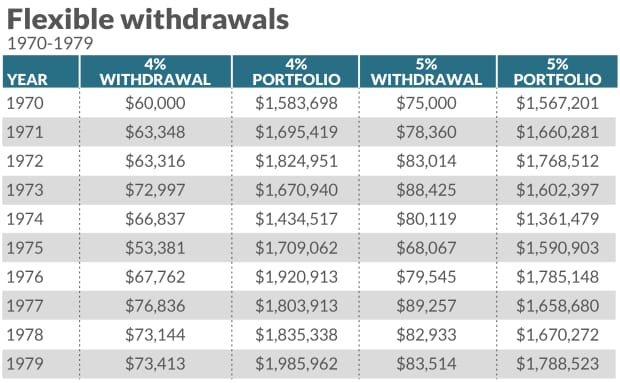If you need a financially snug retirement with ample money accessible, you want to take two primary steps.
First, save plenty when you’re nonetheless working.
Second, withdraw the money in a way that will probably be unlikely to go away you out of money earlier than you run out of life.
In a recent article I described how to design a withdrawal technique that may hold your portfolio wholesome should you have saved sufficient (however solely sufficient) to meet your wants.
Read: A solution to the retirement crisis exists — but only on paper
That entails taking out a hard and fast share of the portfolio worth in your first 12 months, then adjusting upward yearly to account for precise inflation.
If you retire with a portfolio that’s a minimum of 25 occasions the scale of the annual withdrawal you want (in different phrases, with $1 million should you want $40,000 from it the primary 12 months), you’ll most certainly succeed.
That 4% withdrawal charge is advisable by many monetary planners and advisers. But if these withdrawals should hold rising with inflation, they don’t go away a lot “wiggle room” for dangerous occasions in the inventory market.
There’s a greater way. If you’ve saved greater than sufficient to fund your first annual withdrawal, you may undertake what I name a versatile distribution plan.
In this case, you begin by taking a share (let’s assume 4%) of your portfolio the primary 12 months. The different 96% stays invested, and one 12 months later you are taking out 4% of the worth at the moment.
In an article in 2020, I known as this The Ultimate Retirement Distribution Strategy. It may give you extra money to spend, extra money to go away to your heirs, and extra peace of thoughts.
Depending on how a lot “extra” financial savings are in your portfolio, this versatile withdrawal technique could allow you to safely take out 5% every year as a substitute of 4%. That offers you a very nice cushion, as we will see.
Read: Check out our new retirement calculator
True, this plan would require you to tighten your belt at occasions after the market declines. But after favorable market circumstances, you’ll have extra to spend.
It’s a wise way to handle your funds in retirement.
In Table 1, you may see the distinction between fastened and versatile withdrawals, primarily based on precise outcomes and inflation beginning in 1970 (a decade of unusually excessive inflation).
These calculations assume an annual want for $40,000 and an preliminary portfolio price $1 million invested 50/50 in the S&P 500
SPX,
and bond funds. Columns labeled “Portfolio” point out end-of-year worth.
As you may see, in every case the worth of the portfolio held its personal by way of 1979.
But the versatile schedule produced a lot decrease withdrawals in the second half of the last decade. To merely sustain with inflation, a retiree wanted $68,221 in 1979; the versatile association produced simply shy of $49,000 that 12 months — offering solely about 72% of the buying energy a retiree had with $40,000 in 1970.
Saving “more than enough” earlier than you retire isn’t essentially straightforward, particularly should you begin severely saving in your 40s or 50s.
Read: How to make up lost ground if you got a late start saving for retirement
You would possibly want to postpone your retirement by a couple of years to do that. But as you’ll see in Table 2, the monetary advantages may be spectacular.
Table 2 is predicated on the identical assumptions as Table 1 aside from an preliminary portfolio worth of $1.5 million as a substitute of $1 million. This comparability exhibits what occurs if you use a 5% versatile withdrawal charge vs 4%.

Although the 5% portfolio was considerably smaller than the 4% one on the finish of 1979, in later years it was by no means in any hazard of working out of money.
It was price $3.24 million on the finish of 1985, $4.Four million on the finish of 1990, $6.17 million on the finish of 1995, and $8.52 million on the finish of 2000. And of course the withdrawals stored rising as properly.
In this hypothetical retirement beginning in 1970, cumulative 5% versatile withdrawals gave you $129,699 extra to spend in the primary 10 years of retirement, in contrast with taking 4%. After 25 years of retirement, you’d have taken out $204,213 extra at 5% than at 4%.
Having ample money in retirement additionally has robust psychological advantages.
On an imaginary emotional scale, having greater than sufficient money might help you “move the dial” away from worry and nearer to consolation and safety.
Here’s one thing else: Many folks regard their funds (and their internet price) as a way of “keeping score” in how properly they have lived their lives.
I don’t imagine your internet price measures your worth as an individual. And I don’t suggest you reside your life in retirement in accordance to a “financial scoreboard.” But nonetheless, the next rating is all the time nicer than a decrease rating.
The key lesson is that the best way to begin retirement is with extra financial savings than you really want.
And as I’ll present in an upcoming article, that doesn’t have to be as troublesome as you would possibly suppose.
For extra, I’ve recorded a podcast on why I believe versatile distributions are a luxurious price working for.
Richard Buck contributed to this text.
Paul Merriman and Richard Buck are the authors of We’re Talking Millions! 12 Simple Ways To Supercharge Your Retirement.







